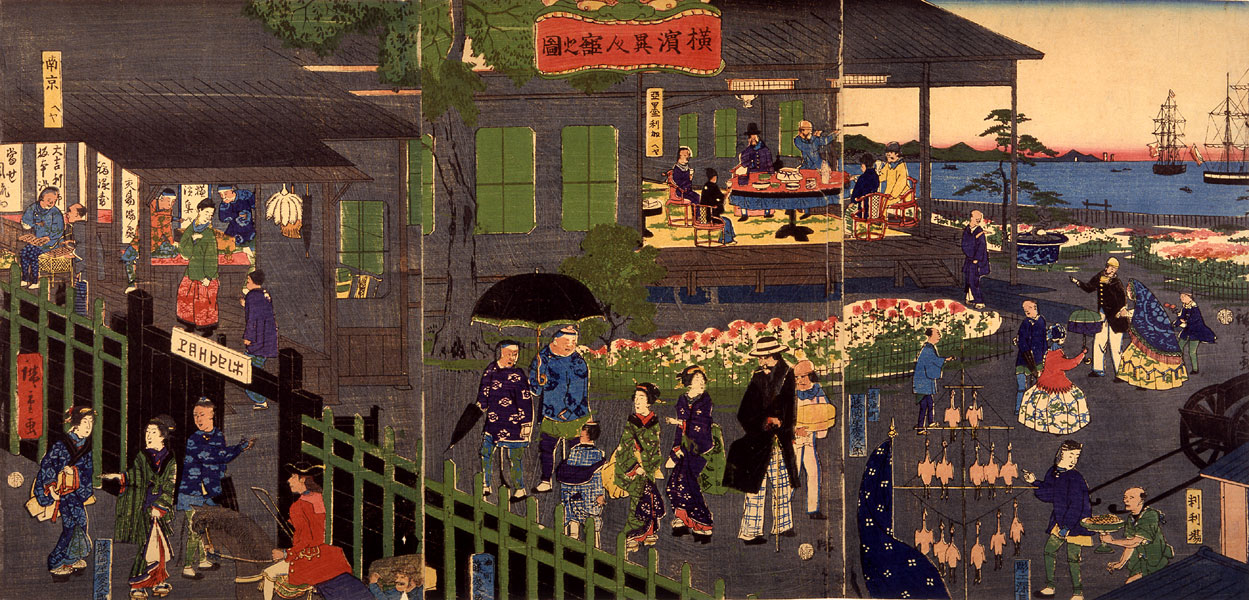
Yokohama ijinkan no zu Title: Picture of a Foreign Building in Yokohama Artist: Hiroshige II (1826-1869) 1861 Format: Woodblock print Medium: Ink and color on paper Dimensions: triptych: 34.9 x73.4 cm (13 11/16 x28 7/8 in.) Source: Arthur M. Sackler Gallery, Smithsonian Institution In contrast to the many prints of Yokohama based on secondary sources, this print, like those of Sadahide, is full of particular details that correspond closely to contemporary descriptions. The location and configuration of the enclosed compound, for example, parallel the accounts of Walsh & Company (later Walsh, Hall & Company), the first American firm to reach Yokohama in 1859. Picture of a Foreign Building in Yokohamais replete with unusual details that provide an exceptionally faithful visual record of the American firm Walsh & Company's Yokohama compound located at lot number two on the Bund, the Westerners' term for the embankment along the harbor's edge. The American and Chinese wings of the main building, here labeled "American room" and "Nanking room," reflect what was known in 1861 about the firm's rented quarters. The buildings are depicted as typical Japanese structures rooms supported by narrow pillars, with the floors built aboveground as platforms but the walls are modified by the novel glass windows preferred by Western settlers. Of particular interest is the garden in the large courtyard, where Japanese, Chinese, and Western visitors stroll. Plants grow in an orderly plot, and a magnificent bonsai pine, or miniature potted tree, can be seen in the distance. Dr. George R. Hall of Walsh & Company, a pioneer resident of Yokohama, assembled an important collection of Japanese plants, which he transported to the United States in 1862. This print suggests that his garden may have attracted visitors from Yokohama's small international community. In the "American room," opened in fine weather to a view of the harbor, two Japanese male visitors clad in kimono sit stiffly in chairs, enjoying refreshments with their American hosts; the "Nanking room" near the gate of the compound has an open structure typical of a Chinese shop. Chinese compradors, employed by the European and American mercantile firms, provided invaluable assistance to merchants of the five treaty nations, who depended upon the compradors' ability to communicate in writing with the Japanese. To the left, Chinese and a Japanese make computations with abacuses, the remarkably efficient calculators used in many parts of Asia. On the walls are inscriptions in cursive Chinese script that resemble the signs in Chinese shops that describe merchandise. Reading from right to left, the inscriptions provide random phrases such as "Yokohama collection, whole place for trade, Fukurokuju [God of Long Life], &kichi print publisher bath …contemporary fashion." Across the courtyard to the right hang rows of ducks to be used for meat. Over the gate, the artist has copied letters of the Cyrillic alphabet, possibly because he thought he was writing English. Hiroshige II's rendition is sufficiently accurate to indicate that he had actually seen Russian writing in some form. Like Sadahide, Hiroshige II must have had an opportunity to visit Yokohama and record his impressions, allowing him to create an unusually accurate portrayal. Perhaps he once had joined the visitors to Dr. Hall's garden in the Walsh compound. [Adapted from Ann Yonemura, Yokohama: Prints from Nineteenth-Century Japan] Visualizing Cultures image number: Y0088 Keywords: Yokohama, foreign settlement, Westerners, Americans, Russians, Chinese, animals, Walsh & Company, Dr. George R. Hall, food, telescope, ships, flags, "Five Nations," racial intermingling of Japanese and foreigners, horseback riding |
On viewing images of a potentially disturbing nature: click here. |
Massachusetts Institute of Technology © 2014 Visualizing Cultures |